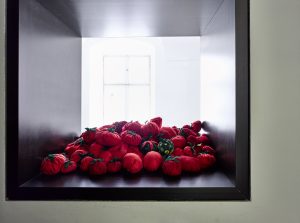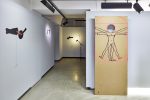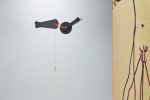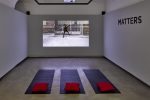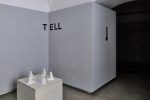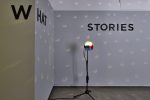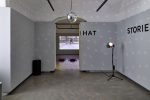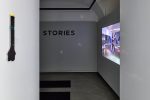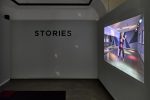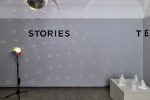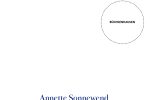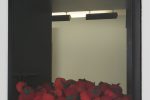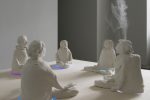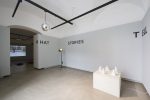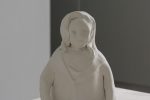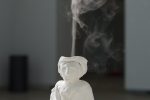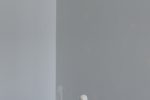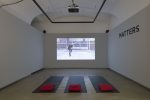Deep Relaxation
Annette Sonnewend
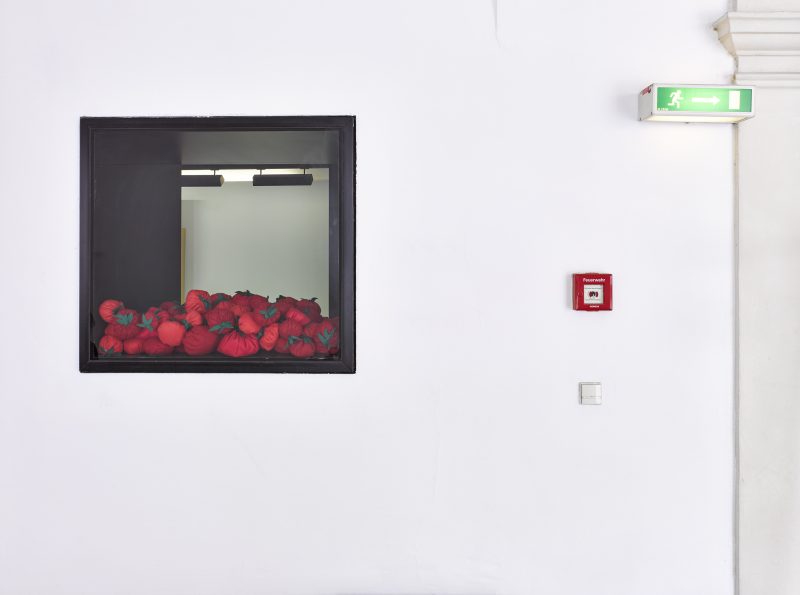
“When, as a child, I was tied to the torture stake and waited and waited for my liberation, at some point I began to prepare a speech that would eventually lead to my freedom. A speech about justice, why violence is not a solution, and about winners and losers. Perhaps the story about immense anger–about tomatoes being thrown in 1968, for example–begins at that stake. What does it mean to be able to think, speak or act and yet to find that ‘shavasana’, the position of the dead, is the only way out? Deep relaxation–what could come of that?” (Annette Sonnewend)
Artist, curator and graphic designer Annette Sonnewend, who was born in Innsbruck and lives in Berlin, interweaves different narrative moments in her performative spatial installation in the Neue Galerie and sets them into multi-layered relationships with each other. The title Deep Relaxation refers to a physical state that offers her the possibility of spiritual permeability and openness, and so grants space for thought experiments.
The starting point for the exhibition is her own subjective archive of memories, information and knowledge. In keeping with her artistic practice, Sonnewend chooses the medium according to the content and employs techniques familiar to us from music, such as mixing, seriality or re-representation. Thoughts about feminist theories, posthumanist considerations, existential questions, sociopolitical ideas and physical experiences lead to the creation of artistic works that are sampled and produced on different stages. The gallery space becomes the setting for a spatial installation with disco atmosphere.
Annette Sonnewend explores different themes in her exhibition without becoming too blatant. For example in an action, the throwing of tomatoes in 1968, which stirred up the male-dominated Socialist German Student Union and is still regarded as the dawn of the new women’s movement.[1] As a subtle allusion to this feminist act, Sonnewend has arranged tomatoes sewn from fabric in the window of the gallery facing the corridor. The performative intervention for the opening of the exhibition and for the Long Night of Museums enables visitors to re-enact the historical action. As the subject, she provides an interpretation of Leonardo da Vinci’s[2] drawing of Vitruvian man, which also questions the humanist, male, white, rational, self-confident, Eurocentric human being as the measure of all things, in the spirit of Rosi Braidotti’s posthumanist theory.
Three recently created objects on the walls should definitely also be understood politically. These are representations of bone parts (thigh and foot bones) that Annette Sonnewend made from different materials (such as yoga mats), as constructs with superhero names such as “Superfemur” and “Superphalanx”. They symbolize a perfectly functioning group made up of a wide variety of materials (bone, cartilage, joint fluids, various tissues). These groups work together to form a joint or a system of organs. If one component is neglected, e.g. the ligaments or the tissue, difficulties arise in the entire system.
Through the sculpture IT MATTERS WHAT STORIES TELL STORIES, a quotation from Donna Haraway[3], Annette Sonnewend presents for discussion the question of what stories form our basis for an explanation of the world, of systems. What do we find normal, which stories support one another, maintain each other as a system, fix each other, normalize each other? So if the humanist human being–male, white, rational, self-confident, Eurocentric–is no longer the measure of all things, as Braidotti thinks, but has made way for a nomadic, non-individual subject, how does that change our explanation of systems? And would a state of deep relaxation make it possible for our thoughts to become permeable and concentrated, allowing other perspectives such as those of animals, plants or cyborgs? And what could a group of people get to emerge from such exercises in thought?
These questions gave rise to the notion of collecting different thinkers together to discuss the issues. The artist has made a first selection from a pool of courageous and interesting women in history, which she brings together here for her solo exhibition in Innsbruck. The figures made of Keramo-Plast take their seats at the round table, as a synonym of power relations, a motif she repeatedly uses in her artistic works: Sylvia Pankhurst (1882 – 1960) – feminist and activist of the suffragette movement in England, socialist and writer; Simone de Beauvoir (1908 – 1986) – writer, philosopher and feminist; Marina Abramović (born 1946) – performance artist, Jesselyn Alicia Radack (born 1970) – lawyer, known as a whistleblower; Theo Sowa (born 1957) – writer and human rights activist.
Another aspect of the spatial installation in the Neue Galerie are two videos, parts eight and nine of TRACING THE TRAIL, Annette Sonnewend’s personal / subjective archive of dance choreographies. This project focuses on choreography as a form of writing – a notation of memories, knowledge and information. A first step towards the creation of an archive of dance scenes is to understand, reconstruct and write down movements in collaboration with dancers. One important aspect for the artist is her own physical experience and the process of developing the choreography together. She is taught the dance steps, she learns to understand them, so that in the end she can master the choreography together with the dancers. Short videos for the archive are created, showing an interpretation of the dance with the original film sound.
Part eight of the archive, a scene from Claire Denis’ Beau Travail (1999), the choreography of which can also be understood as a kind of liberation dance, is installed in the front section of the Neue Galerie. Finally, a tango from the 1921 film Four Horsemen of the Apocalypse is performed in the rear room. This is an early anti-war film and one of the most successful silent films of its time. Annette Sonnewend shot both parts in front of a green box so that they could be relocated elsewhere at any time, in the spirit of a posthumanist, nomadic subject.
In her performative installation Deep Relaxation, Annette Sonnwend offers visitors an insight into her personal archive and opens up multi-layered associations that can also be understood as a thought-provoking impulse.
[1] In her speech at the 23rd conference of SDS delegates in Frankfurt am Main, film student Helke Sander pointed out that educating children and housework were not a private matter for women. She saw the private as political. When the programme of speakers was set to continue without further discussion, Sigrid Damm-Rüger threw tomatoes in the direction of the speaker’s rostrum. On this, see https://www.deutschlandfunk.de/vor-50-jahren-ein-tomatenwurf-als-funke-im-pulverfass.871.de.html?dram:article_id=427706, accessed 16.09.2019
[2] Vitruvian man (Latin homo vitruvianus, also: Vitruvian Figure) is a depiction of man according to the proportions formulated and idealized by the architect and engineer of antiquity, Vitruv(ius). The most famous example is a drawing measuring 34.4 cm × 24.5 cm by Leonardo da Vinci, produced around 1490. https://de.wikipedia.org/wiki/Vitruvianischer_Mensch, accessed 16.09.2019
[3] Donna Jeanne Haraway (* born 1944 in Denver, Colorado) is an historian of natural sciences and researcher in women’s studies, cf.: https://de.wikipedia.org/wiki/Donna_Haraway, accessed 16.09.2019
Women at the Round Table:
Marina Abramović: (born 1946) is a pioneer of Performance Art.
The Serbian-born Abramović works in the media of painting, intervention and sound, creating video works, installations, photographs, objects, solo performances […]. Since the 1970s, she has used her body as subject and medium in exhausting long-term performances to test her physical, mental and emotional boundaries – often risking her life in search of heightened consciousness, transcendence and self-transformation. Her artistic practice also focuses on the questioning of power structures and hierarchies.
Cf.: https://artinwords.de/marina-abramovic/, accessed 16.09.2019
Simone de Beauvoir: (born 1908 in Paris – died 1986 in Paris) was a French author and philosopher. She was one of the founders of the philosophy of Existentialism and a close confidante of Jean-Paul Sartre. Her best-known work, “The Other Sex”, which establishes theses on women’s self-realization in historical and social terms and calls for radical social changes, represents a milestone in the women’s movement.
Cf.: https://www.hdg.de/lemo/biografie/simone-de-beauvoir.html, accessed 16.09.2019
Sylvia Pankhurst, (born 1882 in Manchester, died 1960 in Addis Abeba), women’s rights activist and leader of the suffragette movement in England, socialist and writer. Pankhurst’s parents belonged to the Independent Labour Party. Through her father, a lawyer, Sylvia came into contact with the misery of Manchester’s slums early on. Those impressions had a profound effect on her. Thanks to a scholarship she was able to study art. Together with her mother and sister, she was involved in the Women’s Social and Political Union (WSPU), founded in London in 1903. Protest marches and demonstrations repeatedly led to arrests, impressions that are reflected in descriptions of the infamous women’s prison Holloway in her book The Suffragette Movement (1931). […]
When Mussolini invaded Ethiopia in 1935, she supported the local population. From then on, she devoted herself to social and political work in Ethiopia, wrote about Ethiopian art and culture, and in 1956, together with her son, founded the monthly magazine Ethiopia Observer, which traced Ethiopia’s social development in journalism.
Cf.: http://www.fembio.org/biographie.php/frau/biographie/sylvia-pankhurst/, accessed 16.09.2019
Jesselyn Alicia Radack (born 1970 in Washington D.C.). After studying at Brown University (American Studies, Women’s Studies, Political Science), she graduated from the renowned Yale Law School and subsequently worked at the Ministry of Justice. In 2002, Radack became a whistleblower when she fed documents to the press proving ethical misconduct in dealings with Taliban fighter John Walker Lindh. He had been interrogated without legal counsel after his arrest, contrary to Radack’s recommendation. She had pointed out in several e-mails that such an interrogation was not legitimate according to the relevant laws. Since then, Radack has suffered from restrictions in her professional activities. She was even the subject of criminal proceedings, which were not dropped until 2013.
Quoted from: ed. Angela Richter, Supernerds. Gespräche mit Helden, Alexander Verlag Berlin, 2015, p. 59
Theo Sowa (born 1957 in Cape Coast in Ghana) is a writer and human rights activist. She is an independent consultant in the field of international development with a particular focus on children’s rights and protection. She is also Managing Director of the African Women’s Development Fund (AWDF), a foundation that supports local, national and regional women’s organisations working to empower African women and promote and implement their rights.
Cf.: https://africaphilanthropynetwork.org/our-board/ms-theo-sowa-board-member/, accessed 16.09.2019
Lange Nacht der Museen Saturday, October 5, 2019 von 18.00 – 01.00
Dialogführung um 18.30, Live Performances ab 20.00 – 21.00
Premierentage 2019 Saturday, November 9, 2019:
Live Performances ab 14.00 – 16.00
Duration of the exhibition: September 19 – November 16, 2019
Guided tours on Saturdays at 11.00 and 14.00
Dates: 28.09. and 19.10.2019
